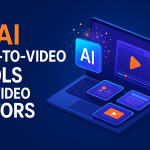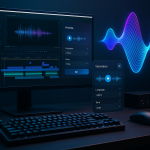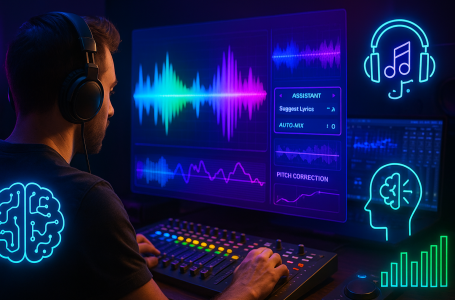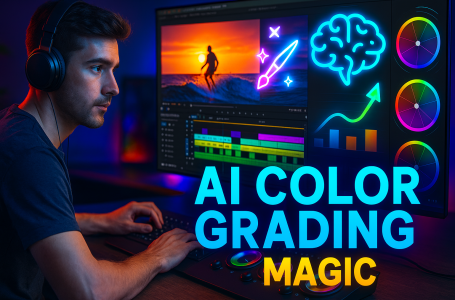
Let’s be honest – being a video editor in 2025 is both incredibly exciting and completely overwhelming. We’re the Swiss Army knives of digital storytelling, juggling everything from 15-second TikTok clips to feature-length documentaries. Whether you’re cutting together YouTube vlogs, crafting commercial spots, editing wedding films, or piecing together corporate training videos, there’s one constant: audio makes or breaks your project.
I’ve been editing for over a decade, and I can tell you that clients might forgive slightly shaky footage, but they’ll never forgive bad audio. That emotional music swell that perfectly captures the bride’s tears? The subtle sound design that makes a product demo feel premium? The crystal-clear narration that keeps viewers engaged for 20 minutes? That’s what separates amateur hour from professional work.
But here’s the thing – we’re often working alone or in tiny teams, expected to be cinematographers, editors, sound designers, and composers all rolled into one. We need that perfect jazz track for the coffee shop scene, but the budget says “royalty-free music from 2015.” We need clean dialogue, but the client recorded it on their phone in a noisy restaurant. We need custom music that matches the exact emotional arc of our 3-minute brand story, but hiring a composer costs more than our entire project budget.
Sound familiar? Yeah, I thought so.
🎯 The Pain Points We All Know Too Well
Before AI tools became game-changers, editing audio was like searching for a needle in a haystack while blindfolded. Here’s what kept us up at night:
Budget constraints were brutal. Those premium stock music libraries? $50-200 per track. Hiring a composer? Easily $500-2000 for a short piece. When you’re working on a $2,000 project, spending 25% of your budget on one song just doesn’t math.
Time management was another nightmare. I remember spending entire afternoons scrolling through hundreds of generic tracks, trying to find something that didn’t sound like elevator music. Then there’s the sound design work – cleaning up dialogue, creating atmospheric sounds, syncing everything perfectly. What should take 30 minutes often stretched into half a day.
Quality consistency plagued every project. You’d find a decent track, but it doesn’t loop well. Or the energy doesn’t match your video’s pacing. Or – my personal favorite – you find the perfect song, use it in three different projects, and suddenly your YouTube channel sounds like a broken record.
Technical headaches were constant. Audio levels all over the place. Background noise that makes dialogue sound like it was recorded in a wind tunnel. Music that starts strong but has an awkward fade-out right when you need it to build. And don’t get me started on trying to make a 2-minute song work with a 3-minute video without it sounding chopped up.
Creative limitations hit hardest when you had a specific vision. You know exactly what the music should feel like – maybe something like Hans Zimmer meets lo-fi hip-hop – but good luck finding that in any stock library. You’d settle for “close enough” and move on, but part of you always wondered what the project could have been with the right audio.
🔊 How AI Music & Audio Tools Changed Everything
Here’s where things get exciting. AI tools didn’t just solve these problems – they completely flipped the script on how we approach audio in video editing.
Custom music generation is probably the biggest game-changer. Tools like Soundraw and Beatoven.ai let you describe exactly what you need – “upbeat electronic music for a tech product demo, 2 minutes long, with a dramatic build at 1:30” – and generate multiple options in seconds. No more scrolling through endless libraries or settling for “close enough.”
Intelligent audio cleanup has saved countless projects. LALAL.AI can isolate vocals from music, remove background noise, and fix audio issues that would have required expensive studio time. Adobe Podcast Enhance makes phone-recorded interviews sound studio-quality with one click.
Adaptive composition is where AI gets really smart. Some tools analyze your video content and generate music that actually follows your cuts, builds with your story arc, and adapts to your pacing. It’s like having a composer who understands editing.
Automated mixing and mastering handles the technical stuff we often rush through. AI Mastering and Landr can make your audio sound professionally mixed without you touching a single EQ band or compressor setting.
Voice synthesis and cleanup opens up new possibilities for narration and dialogue replacement. Tools like ElevenLabs and Murf.ai can generate natural-sounding voiceovers or even replace poor-quality dialogue while maintaining the original performance’s timing.
The best part? Most of these tools integrate directly with our existing workflows. No need to learn entirely new software or completely change how you work.
⚙️ System Requirements for Smooth Editing
Before diving into specific tools, let’s talk hardware. The good news is that most AI music and audio tools are surprisingly lightweight compared to video editing software.
Minimum system requirements for most tools:
- RAM: 8GB minimum, 16GB recommended (though many web-based tools work fine with less)
- OS: Windows 10+, macOS 10.15+, or modern Linux distributions
- Browser: Chrome, Firefox, or Safari for web-based tools
- GPU: Not essential for most audio AI tools, but helpful for real-time processing
- Storage: 10-20GB free space for desktop applications and cached files
Cloud vs. Desktop performance is worth considering. Web-based tools like Soundraw and Mubert work great on modest hardware because the heavy lifting happens on their servers. Desktop applications like some advanced AI mastering tools need more local processing power but give you more control and don’t require internet connectivity.
Low-end setup recommendations: If you’re working on a budget laptop, stick with browser-based tools like Boomy, Beatoven.ai, and Adobe Podcast Enhance. They’re surprisingly capable and won’t strain your system.
High-performance setup benefits: With 32GB+ RAM and a decent GPU, you can run multiple AI tools simultaneously, process longer audio files faster, and use more advanced features like real-time voice synthesis or complex audio analysis.
Software integration varies by tool, but most export standard audio formats (WAV, MP3, AAC) that work with any editing software. Some tools offer direct plugins for Adobe Premiere Pro, Final Cut Pro, and DaVinci Resolve, making the workflow even smoother.
🛠️ The Complete AI Audio Toolkit: 25+ Professional Tools for Video Editors
As video editors, our audio toolkit can make or break a project. I’ve tested dozens of AI audio tools over the past year, and these are the ones that consistently deliver professional results. Each tool below includes honest assessments of strengths, limitations, and real-world applications from an editor’s perspective.
🎵 AI Music Generation Platforms
1. Soundraw
Website: https://soundraw.io
Best For: Custom background music for YouTube, social media, and commercial projects
Platform: Web-based
Pricing: Free tier available, Pro plans start at $16.99/month
Soundraw has become my go-to for client work that needs original music. The interface lets you specify mood, genre, tempo, and exact duration – crucial when you’re working with tight deadlines. The AI generates multiple variations, and you can edit arrangements in real-time.
Video Editor Benefits:
- Generates music that matches exact video length
- Real-time customization of intensity and energy levels
- Copyright-free with commercial licensing included
- Exports in multiple formats (WAV, MP3, STEM files)
System Requirements: Modern web browser, 4GB RAM minimum
Integration: Direct export to most editing software, plugin available for Premiere Pro
2. AIVA (Artificial Intelligence Virtual Artist)
Website: https://www.aiva.ai/
Best For: Cinematic scores, film soundtracks, emotional orchestral pieces
Platform: Web-based with desktop export
Pricing: Free tier, Pro at $11/month, Pro+ at $33/month
AIVA creates sophisticated compositions that rival human composers. I’ve used it for documentary work and corporate videos that need that “big film” sound without the big film budget.
Video Editor Benefits:
- Professional orchestral arrangements
- Style presets for different film genres
- MIDI export for further customization in DAWs
- High-quality stems for mixing flexibility
System Requirements: Chrome/Firefox browser, 8GB RAM recommended
Integration: MIDI and audio export compatible with all major editing suites
3. Beatoven.ai
Website: https://www.beatoven.ai
Best For: Mood-adaptive music that responds to video content
Platform: Web-based
Pricing: Free tier, Creator at $6/month, Pro at $20/month
This tool analyzes your video’s emotional arc and creates music that builds and releases tension at the right moments. Game-changer for narrative content.
Video Editor Benefits:
- AI analyzes video content to match musical emotion
- Automatic sync points with visual cues
- Genre-blending capabilities for unique sounds
- Royalty-free with perpetual licensing
System Requirements: Web browser, 4GB RAM, stable internet connection
Integration: Direct video upload and analysis, standard audio exports
4. Mubert
Website: https://mubert.com
Best For: Endless background music streams, live content, long-form videos
Platform: Web, mobile apps, API integration
Pricing: Free tier, Creator at $14/month, Pro at $39/month
Perfect when you need 3+ hours of consistent background music that never repeats. I use this for live streams and extended corporate presentations.
Video Editor Benefits:
- Infinite music generation without loops
- API integration for automated workflows
- Multiple genre mixing in single stream
- Real-time generation saves storage space
System Requirements: Any modern device with internet access
Integration: API available, works with streaming software and editing suites
5. Boomy
Website: https://www.boomy.com
Best For: Quick song generation for beginners, social media content
Platform: Web and mobile apps
Pricing: Free tier, Creator at $2.99/month, Pro at $9.99/month
The most user-friendly option for editors who want music fast without diving deep into customization. Great for social media content where speed matters more than precision.
Video Editor Benefits:
- Songs generated in under 30 seconds
- Mobile app for on-the-go creation
- Auto-publishing to streaming platforms if desired
- Simple licensing model
System Requirements: Web browser or mobile device
Integration: Standard audio exports work with all editing software
🎧 Advanced Music Generation Tools
6. Ecrett Music
Website: https://ecrettmusic.com
Best For: Scene-specific music creation, video-synchronized compositions
Platform: Web-based
Pricing: Free tier, Individual at $4.99/month, Business at $14.99/month
Video Editor Benefits:
- Scene-by-scene music customization
- Tempo matching to video pacing
- Instrument layering control
- Multiple mix versions per composition
7. Cassette AI
Website: https://www.cassetteai.com
Best For: Text-to-music generation, highly specific requests
Platform: Web-based
Pricing: Credit-based system, packages from $5-50
Video Editor Benefits:
- Natural language music requests
- Unique compositions every time
- Multiple genre fusion capabilities
- High-quality audio output
8. Soundful
Website: https://soundful.com
Best For: Royalty-free music for content creators
Platform: Web-based
Pricing: Free tier, Content Creator at $9.99/month, Music Creator Pro at $29.99/month
Video Editor Benefits:
- Template-based quick generation
- Mood and energy customization
- Commercial licensing included
- Multiple format exports
🛠️ Audio Enhancement & Cleanup Tools
9. LALAL.AI
Website: https://www.lalal.ai
Best For: Vocal isolation, instrument separation, audio cleaning
Platform: Web-based with API
Pricing: Pay-per-use, packages from $15-50
This tool has saved more projects than I can count. Whether it’s extracting clean dialogue from a noisy recording or isolating music from a video reference, LALAL.AI delivers professional results.
Video Editor Benefits:
- Isolate dialogue from background music/noise
- Extract individual instruments from mixed tracks
- Remove vocals for karaoke-style content
- Batch processing for multiple files
System Requirements: Modern web browser, stable internet for upload
Integration: Standard audio file support, works with all editing software
10. Adobe Podcast Enhance
Website: https://podcast.adobe.com/enhance
Best For: Quick dialogue cleanup, interview enhancement
Platform: Web-based, free
Pricing: Completely free
Adobe’s free gift to content creators. I use this on every interview or dialogue track before doing any other processing. The results are consistently impressive.
Video Editor Benefits:
- One-click audio enhancement
- Removes background noise and echo
- Normalizes levels automatically
- Integrates with Creative Cloud workflow
System Requirements: Web browser, Adobe account (free)
Integration: Works with all Adobe Creative Suite, exports standard formats
11. Cleanvoice AI
Website: https://cleanvoice.ai
Best For: Removing filler words, cleaning up speech recordings
Platform: Web-based
Pricing: Pay-per-hour of audio, packages from $10-50
Video Editor Benefits:
- Automatic filler word removal (um, uh, like)
- Background noise reduction
- Dead air trimming
- Batch processing capabilities
12. Descript Studio Sound
Website: https://www.descript.com/studio-sound
Best For: Real-time audio enhancement, professional sound treatment
Platform: Desktop application (Mac/Windows)
Pricing: Part of Descript subscription, starts at $12/month
Video Editor Benefits:
- Real-time processing during recording
- Professional studio sound from any microphone
- Integrates with Descript’s video editing features
- Batch enhancement for existing files
🎤 AI Voice & Speech Tools
13. ElevenLabs
Website: https://elevenlabs.io
Best For: Professional voiceovers, voice cloning, multilingual narration
Platform: Web-based with API
Pricing: Free tier, Starter at $5/month, Creator at $22/month, Pro at $99/month
The voice quality is so realistic it’s almost unsettling. I’ve used ElevenLabs for everything from documentary narration to replacing unusable client recordings.
Video Editor Benefits:
- Photorealistic voice synthesis
- Voice cloning from short samples
- Multiple languages and accents
- Emotional tone control
- Perfect lip-sync timing
System Requirements: Web browser, good internet connection for processing
Integration: High-quality audio exports work with all editing software
14. Murf.ai
Website: https://murf.ai
Best For: Professional voiceovers for commercial projects
Platform: Web-based
Pricing: Free tier, Basic at $13/month, Pro at $26/month, Enterprise at $52/month
Video Editor Benefits:
- 120+ voices in 20+ languages
- Professional voice actors’ vocal patterns
- Team collaboration features
- Commercial licensing included
- SSML support for advanced control
15. Voice.ai
Website: https://voice.ai
Best For: Creative voice effects, character voices, real-time processing
Platform: Desktop and mobile apps
Pricing: Free tier, Premium features via subscription
Video Editor Benefits:
- Real-time voice transformation
- Character voice creation
- Multiple voice effects
- Live streaming integration
- Custom voice training
🔬 Specialized & Advanced Tools
16. AudioLDM
Website: https://huggingface.co/spaces/latent-consistency/AudioLDM
Best For: Experimental sound design, unique audio effects
Platform: Web-based (Hugging Face)
Pricing: Free to use
Video Editor Benefits:
- Text-to-audio generation
- Unique sound effect creation
- Experimental audio textures
- Research-grade AI capabilities
17. AI Mastering
Website: https://aimastering.com
Best For: Automatic mastering, final audio polish
Platform: Web-based
Pricing: Credit-based, packages from $9-49
Video Editor Benefits:
- Professional mastering without expertise
- Multiple platform optimization
- Batch processing
- Before/after comparisons
18. Landr Mastering
Website: https://www.landr.com/en/mastering/
Best For: Professional-grade mastering, music finalization
Platform: Web-based with desktop integration
Pricing: Free tier, Creator at $11.99/month, Pro at $24.99/month
Video Editor Benefits:
- Industry-standard mastering
- Multiple format optimization
- Reference track comparisons
- Unlimited mastering on paid tiers
📊 Additional Professional Tools
19. Cyanite – AI music analysis and library organization
20. Melobytes – Creative audio experiments and voice-to-music
21. Humtap – Mobile music creation from humming
22. Mix.audio – AI remixing and music variations
23. Splash Pro – Professional AI music production suite
24. Endlesss – Collaborative real-time music creation
25. Voicemod Text to Song – Convert text to singing voices
26. Amper Music – Now part of Shutterstock’s AI music platform
Each of these tools serves specific niches in video production workflows. The key is matching the right tool to your specific project needs and budget constraints.
📊 Complete Tool Comparison
| Tool | Type | Best For | Platform | Free Plan | Focus | Min RAM |
|---|---|---|---|---|---|---|
| Soundraw | Music Generator | YouTubers, Creators | Web | Yes | Music | 4GB |
| AIVA | AI Composer | Film, Cinematic | Web | Limited | Music | 4GB |
| Boomy | Simple Generator | Quick Music | Web/Mobile | Yes | Music | 4GB |
| Beatoven.ai | Mood-Based | Video Sync | Web | Yes | Music | 4GB |
| Mubert | Streaming | Long Content | Web/Mobile | Yes | Music | 4GB |
| LALAL.AI | Audio Separation | Cleanup | Web | Limited | Audio | 4GB |
| Cleanvoice AI | Speech Cleanup | Podcasts | Web | Trial | Voice | 4GB |
| Adobe Podcast | Enhancement | Quick Fix | Web | Free | Voice | 4GB |
| ElevenLabs | Voice Synthesis | Narration | Web | Limited | Voice | 4GB |
| Murf.ai | Voiceover | Professional VO | Web | Trial | Voice | 8GB |
| Descript Studio | Audio Suite | Full Production | Desktop | Trial | Audio | 8GB |
| AI Mastering | Mastering | Final Polish | Web | Limited | Audio | 4GB |
| Landr Mastering | Pro Mastering | Commercial | Web | Trial | Audio | 4GB |
| Voice.ai | Voice Effects | Creative | Desktop | Yes | Voice | 8GB |
| AudioLDM | Sound Design | Experimental | Web | Free | Audio | 4GB |
| Cyanite | Analysis | Library Mgmt | Web | Trial | Music | 4GB |
| Melobytes | Creative Suite | Experiments | Web | Free | Mixed | 4GB |
| Humtap | Mobile Creation | On-the-go | Mobile | Yes | Music | 2GB |
| Ecrett Music | Scene-Based | Video Matching | Web | Trial | Music | 4GB |
| Cassette AI | Text-to-Music | Custom Tracks | Web | Limited | Music | 4GB |
| Soundful | Creator Focus | Content | Web | Yes | Music | 4GB |
| Mix.audio | Remixing | Variations | Web | Beta | Music | 4GB |
| Splash Pro | Pro Suite | Advanced | Desktop | Trial | Music | 16GB |
| Endlesss | Collaborative | Team Projects | Mobile/Desktop | Yes | Music | 8GB |
| Voicemod | Text to Song | Fun Projects | Web | Limited | Voice | 4GB |
🧠 Tool Recommendations by Experience Level
Beginner (New to AI Audio Tools)
Recommended: Boomy, Beatoven.ai, Adobe Podcast Enhance Why: Simple interfaces, immediate results, free tiers available. You can get professional-sounding audio without learning complex workflows.
Intermediate (Comfortable with Audio Editing)
Recommended: Soundraw, Murf.ai, LALAL.AI, Cleanvoice AI Why: More customization options, better integration with existing workflows, and professional-grade results with moderate learning curves.
Expert (Advanced Audio Production)
Recommended: AudioLDM, ElevenLabs, Splash Pro, Descript Studio Why: Maximum creative control, advanced features, API access, and the ability to create truly unique audio content.
✅ Essential Do’s and Don’ts
Do’s
- Check licensing before publishing – even AI-generated content may have usage restrictions
- Customize tempo and transitions to match your video’s pacing exactly
- Sync music with visual cues like cuts, text reveals, and emotional moments
- Test different export formats to ensure compatibility with your editing software
- Keep backups of original AI-generated files before making edits
- A/B test different options – most tools generate multiple variations
Don’ts
- Don’t assume all AI music is royalty-free – read the terms carefully
- Don’t use default settings blindly – spend time customizing for your specific needs
- Don’t overload with multiple AI tracks – less is often more in audio design
- Don’t forget to credit when required by the tool’s license
- Don’t skip quality checks – AI isn’t perfect, always listen to the full track
- Don’t rely on one tool – different projects need different approaches
🎯 Your Pre-Publication Checklist
Before you export that final video, run through this checklist:
☐ Music matches video mood – Does the energy align with your visual content?
☐ License and usage rights confirmed – Can you legally use this audio for your intended purpose?
☐ Volume levels tested – Is the music balanced with dialogue and sound effects?
☐ Timing perfected – Do musical peaks align with visual highlights?
☐ Multiple tool comparison done – Did you try at least 2-3 options to find the best fit?
☐ Audio quality verified – Is the export format and bitrate appropriate for your platform?
☐ Backup files saved – Do you have the original AI-generated files stored safely?
☐ Platform requirements met – Does your audio meet YouTube/Instagram/TikTok specs?
The Bottom Line: AI Audio Tools Are Game-Changers
Look, I’ve been editing videos since AI audio tools were science fiction, and I can honestly say they’ve transformed how I work. Not because they’re perfect – they’re not – but because they’ve removed the biggest barriers between having an idea and executing it brillially.
Need a mysterious, ambient track that builds to an epic climax at exactly 2:14? Five years ago, that meant either settling for stock music that was “close enough” or spending hundreds on a custom composition. Today, it means typing a description into Soundraw and having three perfect options in under a minute.
Wrestling with dialogue recorded in a noisy coffee shop? Adobe Podcast Enhance can make it sound like it was captured in a professional studio, and it’s completely free.
The best part isn’t just the time and money saved – though that’s significant. It’s the creative freedom. When you’re not limited by budget or availability, you can focus on what matters: telling the best story possible.
These tools aren’t replacing our creative judgment – they’re amplifying it. We still need to know what sounds good, what fits the story, and how to integrate audio seamlessly with visuals. But now we have an arsenal of AI-powered tools that can execute our vision faster and more affordably than ever before.
Whether you’re a YouTube creator working on your bedroom setup or a commercial editor with high-end clients, there’s an AI audio tool that can make your work better. The key is starting with the basics, learning what works for your specific needs, and gradually expanding your toolkit as you get more comfortable.
The future of video editing isn’t about replacing human creativity with AI – it’s about using AI to unleash more creativity than we ever thought possible. And honestly? That future is already here.













